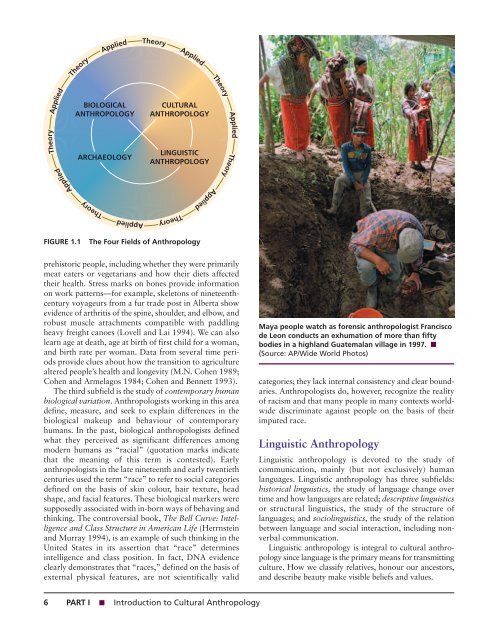PART Introduction to Cultural Anthropology - Pearson Canada
PART Introduction to Cultural Anthropology - Pearson Canada
PART Introduction to Cultural Anthropology - Pearson Canada
Create successful ePaper yourself
Turn your PDF publications into a flip-book with our unique Google optimized e-Paper software.
Theory<br />
Theory<br />
Applied<br />
Theory<br />
Applied<br />
Theory<br />
Applied<br />
Applied<br />
BIOLOGICAL<br />
ANTHROPOLOGY<br />
ARCHAEOLOGY<br />
CULTURAL<br />
ANTHROPOLOGY<br />
LINGUISTIC<br />
ANTHROPOLOGY<br />
Theory<br />
Theory<br />
Applied<br />
Applied<br />
Theory<br />
Applied<br />
FIGURE 1.1<br />
The Four Fields of <strong>Anthropology</strong><br />
prehis<strong>to</strong>ric people, including whether they were primarily<br />
meat eaters or vegetarians and how their diets affected<br />
their health. Stress marks on bones provide information<br />
on work patterns—for example, skele<strong>to</strong>ns of nineteenthcentury<br />
voyageurs from a fur trade post in Alberta show<br />
evidence of arthritis of the spine, shoulder, and elbow, and<br />
robust muscle attachments compatible with paddling<br />
heavy freight canoes (Lovell and Lai 1994). We can also<br />
learn age at death, age at birth of first child for a woman,<br />
and birth rate per woman. Data from several time periods<br />
provide clues about how the transition <strong>to</strong> agriculture<br />
altered people’s health and longevity (M.N. Cohen 1989;<br />
Cohen and Armelagos 1984; Cohen and Bennett 1993).<br />
The third subfield is the study of contemporary human<br />
biological variation. Anthropologists working in this area<br />
define, measure, and seek <strong>to</strong> explain differences in the<br />
biological makeup and behaviour of contemporary<br />
humans. In the past, biological anthropologists defined<br />
what they perceived as significant differences among<br />
modern humans as “racial” (quotation marks indicate<br />
that the meaning of this term is contested). Early<br />
anthropologists in the late nineteenth and early twentieth<br />
centuries used the term “race” <strong>to</strong> refer <strong>to</strong> social categories<br />
defined on the basis of skin colour, hair texture, head<br />
shape, and facial features. These biological markers were<br />
supposedly associated with in-born ways of behaving and<br />
thinking. The controversial book, The Bell Curve: Intelligence<br />
and Class Structure in American Life (Herrnstein<br />
and Murray 1994), is an example of such thinking in the<br />
United States in its assertion that “race” determines<br />
intelligence and class position. In fact, DNA evidence<br />
clearly demonstrates that “races,” defined on the basis of<br />
external physical features, are not scientifically valid<br />
Maya people watch as forensic anthropologist Francisco<br />
de Leon conducts an exhumation of more than fifty<br />
bodies in a highland Guatemalan village in 1997. ■<br />
(Source: AP/Wide World Pho<strong>to</strong>s)<br />
categories; they lack internal consistency and clear boundaries.<br />
Anthropologists do, however, recognize the reality<br />
of racism and that many people in many contexts worldwide<br />
discriminate against people on the basis of their<br />
imputed race.<br />
Linguistic <strong>Anthropology</strong><br />
Linguistic anthropology is devoted <strong>to</strong> the study of<br />
communication, mainly (but not exclusively) human<br />
languages. Linguistic anthropology has three subfields:<br />
his<strong>to</strong>rical linguistics, the study of language change over<br />
time and how languages are related; descriptive linguistics<br />
or structural linguistics, the study of the structure of<br />
languages; and sociolinguistics, the study of the relation<br />
between language and social interaction, including nonverbal<br />
communication.<br />
Linguistic anthropology is integral <strong>to</strong> cultural anthropology<br />
since language is the primary means for transmitting<br />
culture. How we classify relatives, honour our ances<strong>to</strong>rs,<br />
and describe beauty make visible beliefs and values.<br />
6 <strong>PART</strong> I ■ <strong>Introduction</strong> <strong>to</strong> <strong>Cultural</strong> <strong>Anthropology</strong>
















